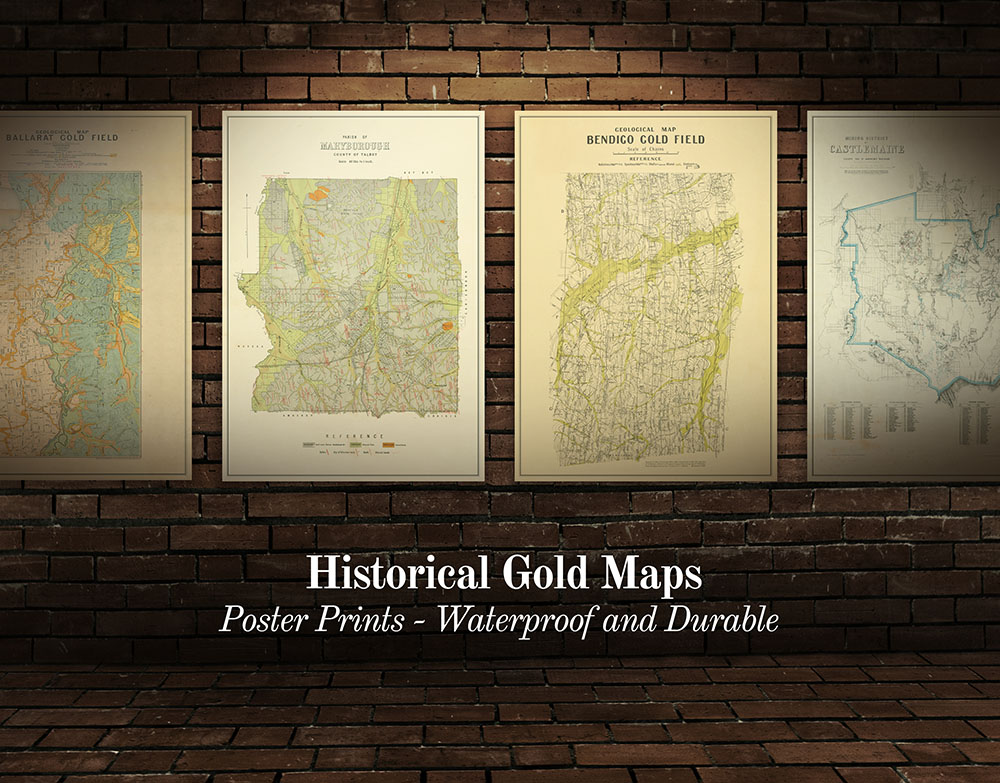
Historical resources such as old newspapers and goldfields maps are extremely valuable when researching gold rush history, or searching for potential new gold prospecting locations.
A quick look through these historical resources soon reveals a plethora of both technical and casual terms relating to gold, mining, miners and geology.
You will find that having an understanding of some of this terminology comes in very handy.
This collection of gold mining terms and their definitions have been selectively extracted from R. Brough Smyth's The Goldfields and Mineral Districts of Victoria.
The book was originally printed in 1869 and made available online by the Geological Survey of Victoria.
Smyth's glossary was written during the first few decades of the Victorian gold rush and offers a valuable insight into the terminology of the time.
The mining terms presented on this page have been separated into the following categories:
- Gold
- Slang, jargon, etc
- People
- Geology and landscape
- Machinery, tools and equipment
- Treatment and processes
- Underground mining
- Blasting
- Open cut mining
- Shallow surface mining
- Claims and licences
Gold

The Great Nuggets of Victoria, J. Richardson, 1891. Image source: State Library Victoria.
- Flour-gold- the finest alluvial drift-gold. It is found in the deep lead at Huntly, coating quartz pebbles in cement.
- Heavy gold - gold in large particles. Sometimes called "shotty gold," when it has the appearance of a gun-shot.
- Lob of gold - a very large quantity or rich deposit of gold contained within a small area, sometimes called a pile of gold.
- Nugget - a lump of gold. The modern form of niggot.
- Paint-gold - gold found in cement, of such remarkable fineness as to resemble paint or gilding.
- Prospect - the yield of gold got from a dish of washdirt, or from the bottom of a shaft, or from roughly reduced quartz.
- Shotty gold - see Heavy gold.
- Spangle gold - gold in the form of smooth flat scales.
- Specimen - a piece of quartz containing gold which is visible to the naked eye.
Slang, jargon, etc
- Bay of Biscay Country - see Crab-holes, Dead-men's graves.
- Color - when only very minute particles of gold are found in a "prospect" the miner is said to have got the "color".
- Crab-holes - Holes often met with in the bed-rock in alluvial mining. They have the appearance of having been formed by eddies of water. Crab-holes on the surface are in general due to the unequal decomposition of the underlying rocks. After rains cray-fish are found in the muddy water and mud. In the basaltic plains, as well as in the palaeozoic country, these holes occur, and are often the cause of serious accidents. See Dead-men's graves, Bay of Biscay Country.
- Dead-men's graves - applied to country generally basaltic, where, owing to the unequal decomposition of the underlying rock, humps like graves occur.
- Jeweller's-shop - a claim in which occur patches of extraordinary richness.
- Pile - A fortune. A miner who has got a great deal of gold is said to have "made his pile".
- Tucker - bare subsistence.
- Tucker ground - ground which yields only sufficient gold to provide miners with tucker.
People

Diggers on road to Bendigo, S. T. Gill. Source: State Library Victoria.
- Digger - commonly applied formerly to all persons who searched for gold ; and now generally restricted to those who seek for gold in the shallow alluviums.
- Fossicker - is to the miner as is the gleaner to the reaper. Picks the crevices and pockets of the rocks.
- Furnisher - a capitalist who by erecting machinery for, or otherwise assisting a party of miners working a claim, becomes entitled to a share of the profits.
- Hatter - one who works alone. He differs from the fossicker who rifles old workings, or spends his time in trying abandoned washdirt The hatter leads an independent life, and nearly always holds a claim under the bye-laws.
- Jumper - one who seeks to get possession of a claim or a mining interest by dishonesty or trickery.
- Mate - one engaged with others in mining operations, or prospecting. A friend. A companion.
- Pitman - usually restricted to one who attends to the pumps and timber of the engine-shaft and the security of the permanent levels, etc. One who works in a pit.
- Prospector - one engaged in searching for gold or other metals or minerals.
- Sleeping partner - a shareholder in a claim who does not work in it. One who supplies capital only. Sometimes called a furnisher.
- Tributer - one who contracts to work a mine or claim for nominal wages, and a fixed share of the products, or for a percentage only.
Geology and landscape
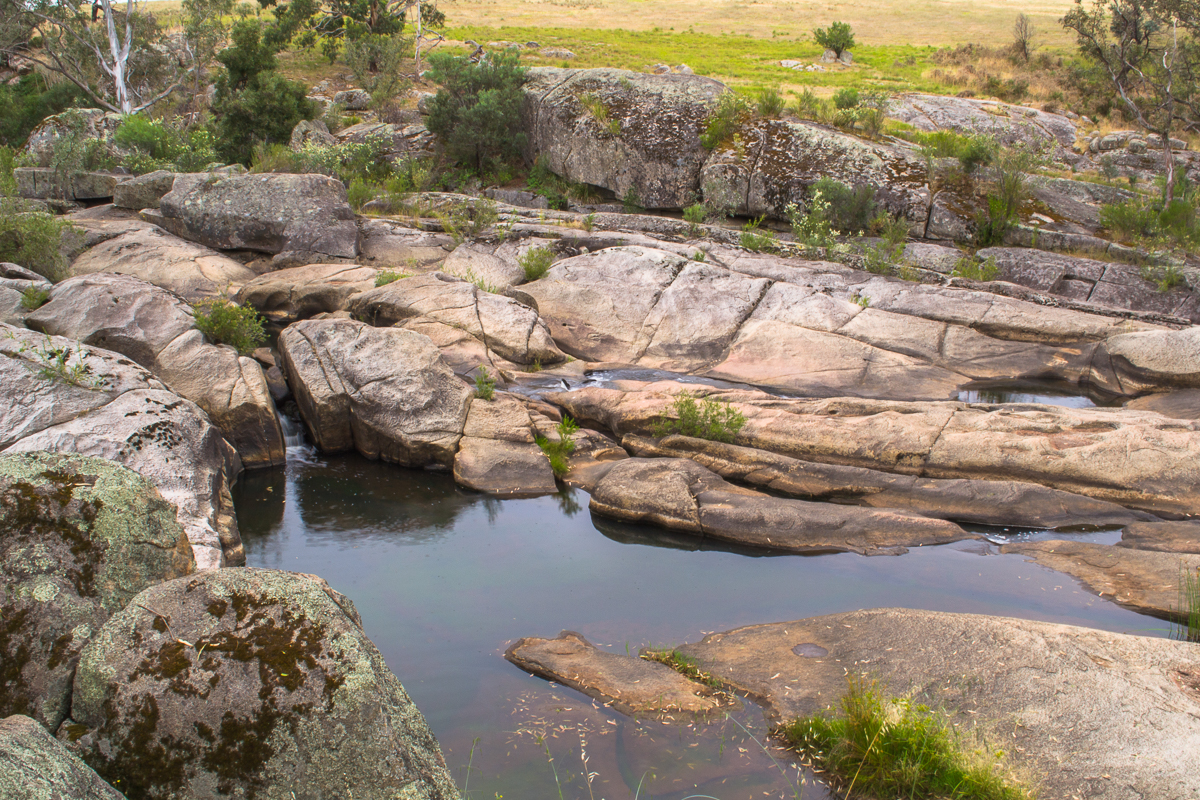
The Cascades, Metcalfe VIC
- Alluvial - characterizing soils and drifts deposited by aqueous agencies now or recently operative.
- Alluvion / alluvium - the soils, sands, quartz-drifts, clays, and auriferous gravels of recent formation found in the lines of watercourses, in flats, and on the slopes of hills in the (in some cases obliterated) lines of drainage, are called alluviums. The term is too often used vaguely.
- Basin - the drainage area of a river, creek or watercourse. An area within which the surface trends towards a common centre.
- Bed-rock - the strata on which the auriferous or lowest alluvial stratum lies.
- Black sand - commonly applied to all the black and heavy minerals which usually accompany gold. Tin ore, titaniferous iron sand, magnetic iron, iserine, pleonaste, etc etc, are generally called "black sand."
- Cement - conglomerate ; quartzite ; quartz-gravel, with an argillaceous, silicious, or ferruginous cement ; auriferous pudding stone.
- Dip - underlie. The dip of the beds is always at right angles to the strike. The angle of dip is the angle at which strata lie to the plane of the horizon.
- Drift - loose sand or a very loose friable alluvial deposit met with in some places close to the washdirt ; and, when so situated, very dangerous, requiring close timbering and great care in working.
- Dyke - applied to masses of intrusive rock occurring in a manner somewhat similar to veins. The dykes of syenitic diorite, at Wood's Point, are intersected by horizontal veins of quartz.
- Flat - a low even tract of land, generally occurring where creeks unite, over which are spread many strata of sand and gravel, with the usual rich auriferous drift immediately overlying the bed-rock.
- Gully - a watercourse ; a line of draining ; a feeder of a creek.
- Gutter - the lowest portion of a lead. A gutter is filled with auriferous drift, or washdirt, which rests on the palaeozoic bed-rock.
- Headings - coarse gravel or drift overlying the washdirt.
- Lead - a deep alluvial auriferous deposit or gutter. A lead, correctly defined, is an auriferous gully or creek, or river, the course of which cannot be determined by the trend of the surface, in consequence of the drainage having been altered either by the eruption of basalt or lava, or the deposition of newer layers of sand and gravel.
- Lode - a quartz reef. A mineral vein.
- Patchy - characterising alluvial ground where the rich washdirt occurs in patches, and vein-stuff where the gold is distributed irregularly.
- Pipe-clay - a soft white clay, which is often found lying between the bed-rock and the washdirt. Its thickness varies from a mere trace to many feet.
- Pocket - a crevice containing gold either in the bed-rock or in the quartz of a reef.
- Pothole - a hole in the bed-rock, or a small area which is lower than the surrounding bedrock.
- Quartz-boil - an outcrop of a quartz reef on the surface, or an outburst or extension in width of the reef beneath it.
- Quartz-reef - a lode or vein of quartz.
- Range - a chain of hills. In Australia the main line of high ground to which the coast line is rudely parallel, and which stretches from Cape York on the north to Wilson's Promontory on the south, is called the Main Dividing Range or Cordillera, Subordinate ranges connected therewith (not necessarily less elevated) are called spurs.
- Reef - the term is applied to the up-turned edges of the palaeozoic rocks. The reef is composed of slate, sandstone, or mudstone. The bed-rock anywhere is usually called the reef. A quartz-vein ; a lode.
- Reef-wash - a deposit of washdirt spread over an expanse of flat or undulating reef (i.e. bed-rock), or lodged in a hollow in the reef, above the level of the gutter.
- Rubbly-reef - a vein very much broken up.
- Saddle-formed reef - a reef the upper portion or cap of which as the appearance of an inverted V.
- Spur - an irregular quartz vein. A subordinate range of hills: Thus we say "a spur from the Great Dividing Range".
- Strike - the inclination or fall of a reef in its course ; exhibited in the cap, or sometimes in the thinning out or re-formation of a reef. The line of outcrop of a stratum. The dip is necessarily at right angles to the strike.
- Underlie - (commonly called underlay) - the dip or inclination of a reef or lode. The angle of inclination from the plane of the horizon or level.
- Vein - a reef. A lode.
- Washdirt - the auriferous gravel, sand, clay, or cement in which the greatest proportion of gold is found.
Machinery, tools and equipment

Stamp battery on display at a park in Blackwood.
- Battery - a group or set of stampers ; or the whole of the stamp-heads collectively attached to an engine.
- Borer - see drill.
- Buddles (concave and convex) - Machines somewhat similar in construction and use to puddling machines. They are used in alluvial mining for extracting gold from sludge, and in quartz mining for separating pyrites from tailings...
- Cradle - The common cradle is a wooden box from three to four feet in length and one foot to one foot eight inches in width. It has a moveable hopper and slide, and is fixed on wo rockers. When it is in work it is placed on an inclined plane.
- Crushing machine - an engine working stamping machinery for reducing quartz and similar to the Cornish stamping machine. The only important difference is that, in the crushing machine, the stampers in most machines revolve, whilst the Cornish stamps do not.
- Derrick - see Whip.
- Dolly - An instrument used by diggers for dividing and mixing the tough clay or cement with water in the puddling tub. A log of wood shod with iron and suspended from a sapling over a stump, and used in the early days for crushing quartz.
- Drill - An instrument used in boring holes for blasting purposes. A borer.
- Elevator pump - an endless band running over two drums ; on this band are fixed, at short intervals, small iron or tin buckets. It is used for draining shallow alluvial claims, and is sometimes called a bucket machine.
- Flume - the more artificial portion of a race or tail-race, consisting of piping, hose, or wooden boxes let into each other. Usually applied to wooden troughs for conveying water.
- Ground-sluice - a channel cut in the bottom or bed-rock, into which the earth is conveyed by a stream of water. It is sometimes lined with sawn planks. False bottoms formed of stout battens, framed together and laid lengthwise in the sluice are occasionally used to protect the wooden bottom from the wearing action of the stones, etc, passing through the sluice. Some sluices are paved with large stones, and others are paved with blocks of wood, grain on end. Ground-sluices are employed where the bottom is sufficiently high to afford the necessary fall for the stuff passed through the sluice.
- Gutter-flags - flags fixed on the surface to denote where the course of a gutter or lead underground has been discovered.
- Hand-whip, lever whip - is composed of a rough post fixed vertically in the ground, to the upper end of which a long straight sapling is fastened at its centre. A bucket is attached by a rope to the thin end of the sapling, and a bag filled with gravel is tied on to the thick end. This bag acts as a balance to the full bucket. Hand-whips are employed in shallow alluvial mining, for raising the stuff to the surface. Trees situated close to the workings are often used as uprights.
- Harrow - somewhat similar to the harrow of the agriculturist. Harrows are fixed to the pole of a puddling machine, and being dragged round, divided and mix the auriferous clays with water.
- Hoe - an agricultural implement much used on the goldfields for separating the dirt washed in long-toms.
- Hopper - the square wooden frame fitted on the top of a cradle. The bottom of it is made of iron, and perforated, the holes being about a quarter of an inch in diameter. A wooden framework, which receives quartz that is to be crushed, and so placed as to deliver the quartz into the stamper-box.
- Horse puddling machine - see Puddling Machine.
- Horse-pump - an ordinary lifting pump operated by horse-power.
- Hydraulic hose - a common hose used in gold-washing for conveying water to alluvial claims, where by the fall and pressure of the water the detritus is broken down and washed. The canvas hose used in California and other countries for hydraulic mining, is usually covered with iron rings or close cord netting, and the pressuresuch a structure bears is very considerable. With a large volume of water, vast quantities of detritus and gravel can be removed with little manual labor. A pressure from 60 lbs. to 100 lbs. to the square inch is common. Only where the fall is considerable, and water abundant, can hydraulic mining be profitably pursued.
- Kibble - see Whim-bucket.
- Kiln - a place prepared for the calcining of quartz. A kiln of quartz is sometimes rudely stacked on a layer of logs and brushwood, and there roasted.
- Launder - a flume or aqueduct. A trough into which falls the crushed quartz after it passes the battery and tables. A spout through which a buddle is fed.
- Long-tom - a gold washing machine or table about twenty-four feet in length, two feet in width, and with sides twelve inches in height. The bottom is lined with sheet-iron one-eighth of an inch in thickness The table rests on logs of wood laid on the ground, which give it a slight fall. The washdirt is thrown into the table at its head (near the mouth of the pump, which supplies it with water), and it is mixed with water by forks and gradually washed down to the hopper, through which the finer portion passes on to the ripple-board, where the gold is caught by the ripples and blankets ; the coarser gravel, which will not pass through the hopper, is cast away.
- Mill - crushing machine, puddling machine, chilian mill - a general term for such machinery. A pass.
- Mill-battery - a crushing machine with chilian mills attached to it.
- Pan - a large shallow enamelled-iron basin used in panning-off. A shallow tin dish.
- Poppet-heads - cross pieces of timber above the mouth of a shaft, on which rest the axles of the pulleys or sheaves which guide the ropes attached to the cages or tubs in the shaft. Commonly applied at Ballaarat to the whole erection (consisting of walls and roof) which covers the shaft and the brace.
- Puddling machine - a puddling machine consists of a circular space, the sides and bottom which are lined with iron or laths of hardwood, with a perpendicular shaft moved by steam or horse-power, working in the centre of a circle. To the shaft are attached two harrows, which are dragged around the circular space, puddling the washdirt with which it is charged. Water is supplied in sufficient quantities to keep the charge in such a condition as to admit of its being puddled by the action of the harrows. The gold is left in the bottom of the circular space, and is finally cleaned by panning.
- Pulley - see Whip.
- Race - an aqueduct, a canal, or artificial watercourse used for conveying water from a stream, a spring, or a dam, to a mining claim or a mill. Races are cut through soil and rock, and where a saving in length is to be gained by crossing a gully instead of skirting a hill, the water is conveyed in flumes (boxes or troughs constructed of wood).
- Riddle - a small dish having a perforated bottom. It is used as a sieve to divide the coarse gravel from the silt, after the operation of cradling, and before panning off.
- Ripple-board table - an inclined plane, of lengths varying from about eight to fourteen feet. Ripples are cut in it at about two and a half feet from each other. All the reduced quartz from the stamper-boxes passes on to and over these ripple-board tables.
- Scraper - an instrument used for cleansing a hole which is being bored or drilled.
- Shaking-table - a slightly inclined ripple-table, which receives a peculiar motion from an eccentric.
- Shears - sheers - see Poppet-heads.
- Sieve - this term is sometimes used to denote the gratings fixed in stamper-boxes. A gold sieve is a small tin dish which has a ire gauze bottom and is used by gold-buyers to separate the heavy gold from the lighter or fine gold and dust.
- Sludge-mill - a puddling machine in which the sludge from another machine is washed.
- Sluice-box - a flume with ripples or false bottoms, having holes bored in them for catching gold. It is a simple, and when properly used, an effective gold washing machine ; its thoroughness depending principally on its length.
- Tailings-machine - a crushing machine for reducing and extracting the fine gold from the quartz tailings run off from a crushing machine.
- Tail-race - an artificial channel which drains a claim, or which conveys water from a claim, or a mill, or a puddling machine, after it has been used.
- Truck - a tram wagon used in removing stuff from underground workings to the crushing machine or puddling machine on the surface, or to the mullock heap.
- Whim - a structure of strong timber keeping in position a large horizontally working drum, around which the ropes attached to the buckets working in the shaft are wound. Underneath the drum there is a long beam with shafts, to which the horse is harnessed.
- Whim-bucket - a bucket made of wood and bound strongly with iron. It is used for raising quartz to the surface, for bailing, lowering timber, and other purposes.
- Whip - A post about twenty feet in length, fixed at an angle of about 45 degrees to the ground, in which it is firmly embedded. The thinnest end of the post rises about eight feet above the centre of the mouth of the shaft. At this end is fixed an iron wheel or sheave, having grooved circumference, in which a rope runs. At one end of this rope is fastened a bucket, which is raised or lowered by a horse travelling backwards and forwards.
- Windlass-barrel - the roller on which the rope of a windlass winds.
- Windlass-stand - the two uprights in which the axle of the windlass-barrel is fixed, and on which it revolves.
Treatment and processes

Quartz kilns at the North British Mine in Maldon, used for calcining quartz in preparation for crushing.
- Amalgam - the compound of mercury with gold or silver.
- Amalgamation - the process of effecting the compound of mercury with gold or silver.
- Calcining - roasting or burning quartz, for the purpose of decomposing the pyrites, and driving off the sulphur, arsenic, and other substances which interfere with the process of amalgamation.
- Cleaning-up - see Washing-off and Panning-off
- Crushing - the reduction of quartz by a crushing machine.
- Hopperings - gravel caught by the hopper in cradling operations.
- Panning-off - the process by which gold is separated from the gravel, etc, left in the cradle or sluice after alluvial washing, or from the crushing quartz, etc, remaining in the stamper-boxes in quartz crushing. So called from a metal pan or dish being used in the operation of panning-off.
- Raw-quartz - quartz that has undergone no treatment, such as burning or reduction, prior to being placed under the stamp-heads.
- Sludge - mud flowing from a puddling machine. "Tailings" is the word usually applied to the stuff flowing from a quartz-mill.
- Tailings - the detritus carried off by water from a crushing machine or any gold-washing apparatus.
- Washing - the whole operation of cleansing gold from washdirt.
- Washing-off - washing up - the cleaning out of the boxes, tables, blankets, etc etc, in quartz crushing, and of the puddling machines, buddles, sluices, etc, in alluvial washing The resulting gold is got by this operation. The last process of separating gold from the associated sand, etc, by hand, after the process of separation has been carried to its utmost limit by machinery.
Underground mining
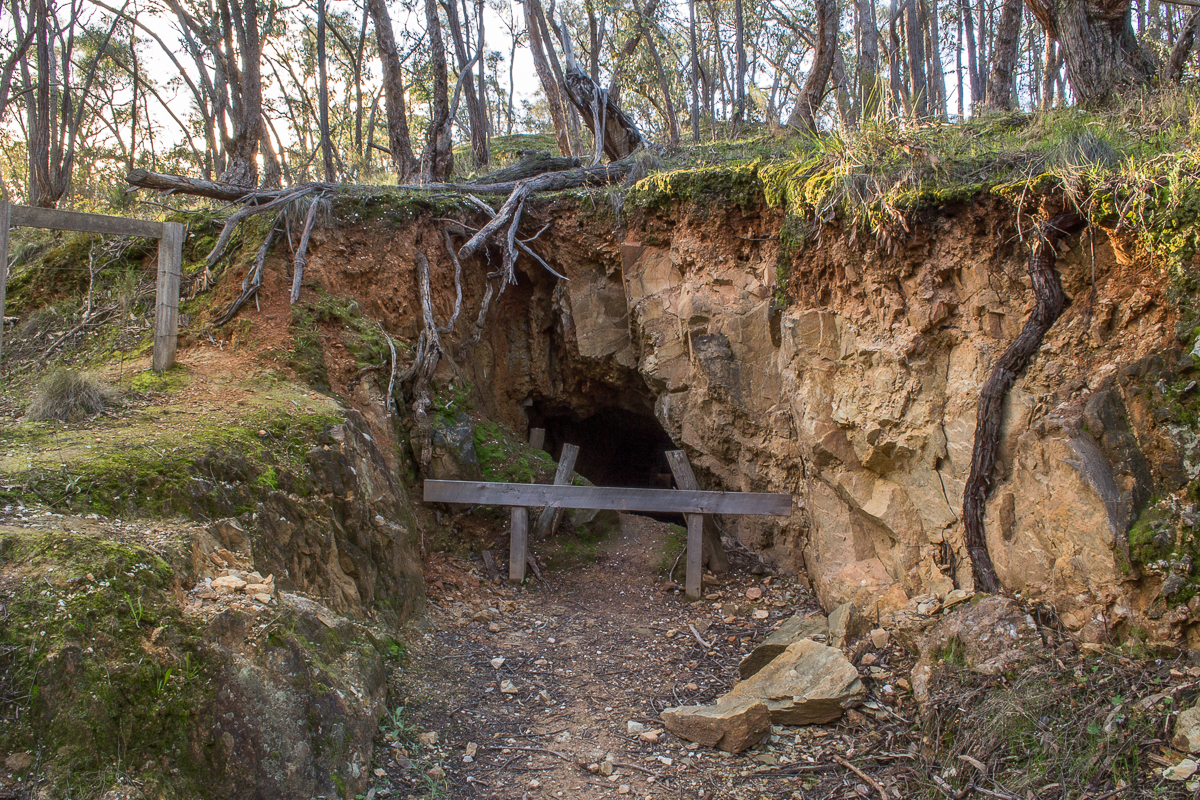
Mine adit at Eureka Reef, Chewton VIC
- Adit - A horizontal gallery of drive, opening out either from some part of the slope or from the base of a hill or range into a mine, either for the purpose of drainage or ventilation, or for ordinary mining purposes.
- Bottom - the bed-rock. When a shaft reaches the bed-rock, the gold obtained from the bottom of the shaft is said to be the prospect from off the bottom.
- Brace - the mouth or collar of a shaft.
- Cage - a structure of iron and wood, in which tram-waggons are placed, to be raised or lowered in shafts, etc.
- Cross-cut - a level driven at right angles to the direction or course of the strata or reefs for prospecting, or for other mining purposes.
- Drive - a level or gallery driven horizontally in the reef.
- Drop-shaft - a monkey-shaft, down which earth or other matter is lowered by means of a drop (i.e. a kind of pulley with a break attached). The empty bucket or truck is brought up as the full one is lowered.
- Engine-shaft - the main shaft in which the pumps and pump-rods are fixed. It is sometimes called the water shaft, and the drainage shaft. Usually the deepest shaft in a mine.
- Face - the end of a drive. A perpendicular cutting of ground anywhere. The wall, cheek, or side of a reef.
- Footholes - holes cut in the sides of shafts or winzes to enable miners to ascend or descend them.
- Footway - see Ladder-road
- Knocker - a hammer fixed near the mouth of a shaft, and which may be moved by pulling a line hanging down the shaft. It is used as a medium of communication between men underground and those at the surface.
- Ladder-road - the connection of ladders by which miners travel to and from the underground workings of a mine.
- Main-brace - the platform at the mouth of a shaft, to which the trucks of auriferous dirt are removed from the cage.
- Monkey-shaft - is a shaft rising from a lower to a higher level (as a rule perpendicularly), and differs from a blind-shaft only in that the latter is sunk from a higher to a lower level.
- Mullock - rubbish, dirt, stuff taken out of a mine - the refuse after the vein stuff is taken away ; pyritous slate, etc etc.
- Paddock - a place built near the mouth of a shaft where quartz or washdirt is stored.
- Pass - an aperture left open in the workings, through which communication is held between the backs and the drives. They serve as outlets through which quartz or other vein-stuff can be conveyed, as well as for the purposes of ventilation.
- Pillar - a portion of the virgin ground left in mining to support the roof or wall. An artificial pillar of masonry to support drives.
- Pillar-drive - a wide irregular drive, constructed in firm dry ground, without the use of timber, in which the roof is supported by pillars of the natural earth, or by artificial pillars of stone.
- Plat - a chamber or excavation made at the point of departure of a level from a shaft.
- Puddle-clay - the tough clay made use of in puddling a shaft
- Puddling a shaft - damming back water by ramming tough clay between the slabbing or timber of a shaft, and the rock or drift, etc, through which the shaft may be sunk.
- Reef-drive - a drive cut or constructed entirely through the bed-rock, and either above or below the level of the gutter, or along the face of the reef, or partly in the reef. Reef-drives are usually cut for the purpose of seeking the gutter, or seeking reef-washes, or working out reef-washes, or as air-drives for ventilation.
- Rise - work done in the back of a level. The upper portion of a stope.
- Shaft - a pit. A hole sunk in the ground. A rectangular or square pit sunk on a reef or on a gutter.
- Shoot - a place for quartz or washdirt, beneath which tram-waggons are filled by raising a slide-door. A run of gold in a quartz reef, or the re-formation of quartz in a reef. An inclined wooden spout through which vein-stuff is conveyed.
- Skids - wooden rails or guides on which sledges, trucks, buckets, or bags, slide or run.
- Skid-shaft - a shaft sunk more or less on the underlie, and in which the buckets slide between two wooden rails or skids.
- Stope - see Stoping.
- Stoping - working out the reef upwards between two levels by steps or stopes carried forward one after the other (about six for more feet in height), at such distances that the working of the upper stope shall not interfere with the next beneath it. This stoping continues until eventually the whole height of the reef between the two levels is in work Stoping in alluvial mining is levelling the bottom of a drive.
- Stow - to pack a drive with stone or mullock in such a way as to give support to the roof.
- Stull - logs of wood laid across the workings at intervals of about five feet, with an elevation to the hanging-wall of 50 to 75 degrees. The lower end of a stull-piece is cut in rather a peculiar manner, and fitted into a hitch in the footwall, and the upper end is fixed against a head-board placed on the hanging-wall. These stull-pieces are covered with laths or slabs, and form a storage place for mullock. Stulls are used in the backs of drives, which were not previously timbered when the reef or lode was stoped away.
- Sump - the bottom portion of an engine shaft beneath the deepest level. The lowest part of a shaft, into which the water from the workings flows.
- Tunnel - a level put in from the side of a hill, or from the bank of a river, to mine washdirt or a quartz reef, or for drainage purposes.
- Water-shaft - the drainage-shaft, usually the deepest shaft in a mine. See Engine shaft.
- Winze - a small shaft sunk in the bottom of a level, or between two levels, for ventilation, or for working the reef, or for communication. Winzes often become passes. See Pass.
Blasting
- Blast - An explosion of gunpowder or guncotton in a bore-hole. Ignition of carburetted hydrogen. A shot.
- Blast-holes - Holes bored for the purpose of blasting.
- Charge - the gunpowder or guncotton used in a blast.
- Fuse - Fuze - a small cylindrical cord filled with powder or other combustible matter used for igniting the powder in a bore-hole.
- Shot - the firing of powder or gun-cotton in a blast.
- Spent shot - a blasting hole which has been prepared for blasting and fired, but which has not rent or broken any rock. Fissures in the rock are often the cause of spent shots.
- Swob-stick - a stick about the same size as a drill. It has a frayed mop-like end, which is inserted in the bore-hole for the purpose of cleaning out the sludge formed during the operation of boring, and for drying the bottom of the hole.
Open cut mining
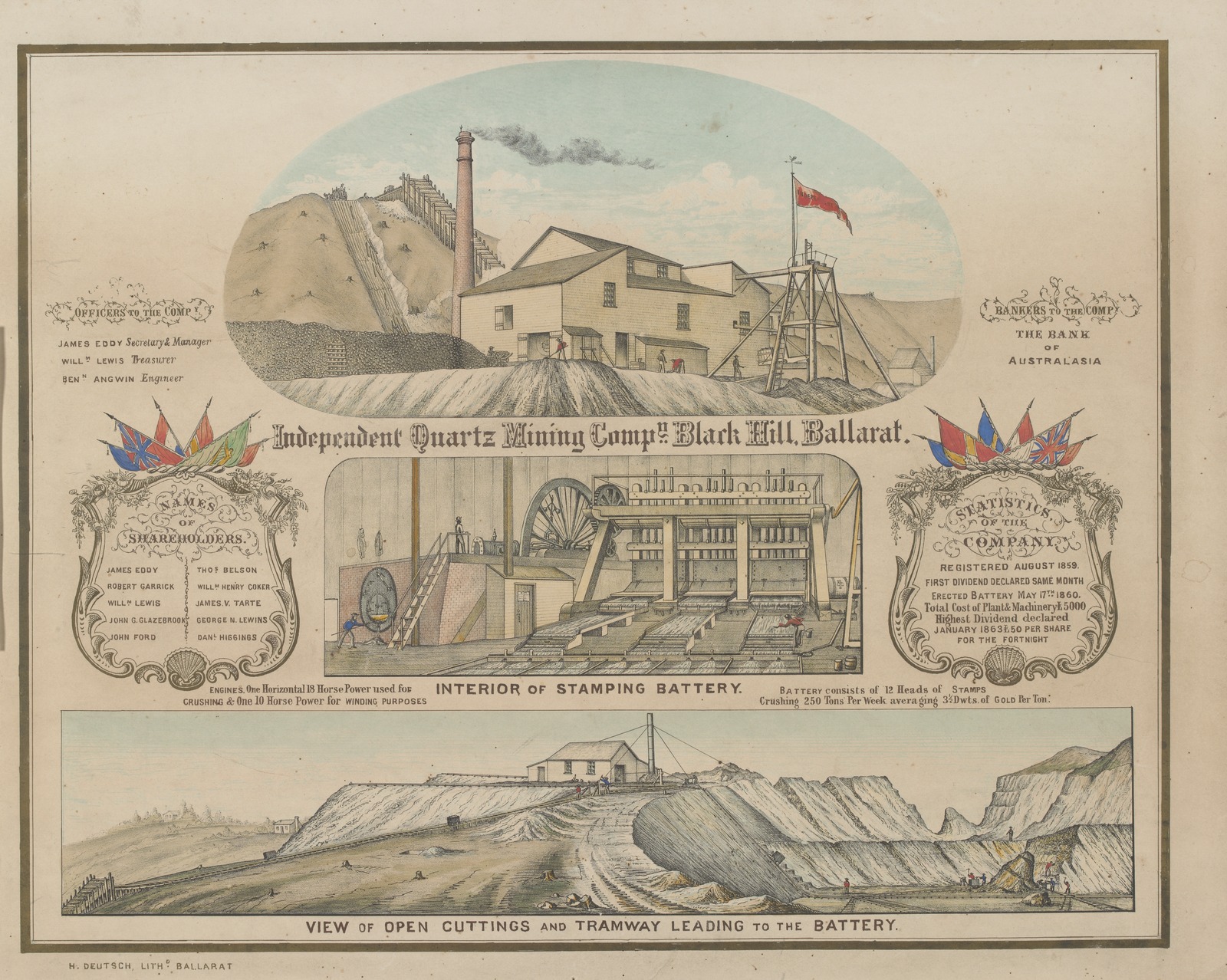
Image showing an open cut mine at Black Hill, Ballarat VIC, 1863. Source: State Library Victoria
- Open cutting - an excavation made for the purpose of getting a face wherein a tunnel can be driven either for mining veins or alluviums. An open-cast. A quarry on a quartz vein.
Shallow surface mining
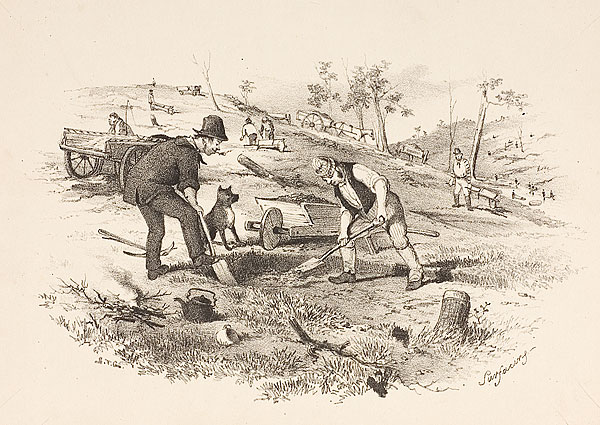
Surfacing, S.T. Gill, 1852. Source: National Gallery of Australia.
- Paddock - an excavation made for procuring washdirt in shallow ground.
Claims and licences

Miner's Right, issued in 1881. Image source: State Library Victoria.
- Bank-claim - a claim which includes the bank of a river or creek.
- Bank-right - the privilege of diverting water to a bank-claim.
- Bed-claim - a claim which includes the bed of a river or creek.
- Claim - a portion of ground marked off in accordance with the mining bye-laws of the district, and held by virtue of miners' right.
- Creek-claim - a claim which includes the bed of a creek.
- Creek-right - the privilege of diverting water for the purposes of working a creek-claim
- Exempted claim - a claim allowed by the mining bye-laws to remain idle for a certain term, and for which an exemption certificate has been obtained from the mining registrar.
- Extended claim - A block or frontage claim, the extent of which has been increased by the annexation to the original claim of an additional area of ground or length of lead, or by the amalgamation of one or more claims with the original claim.
- Fencing in a claim - making a drive round the boundaries of an alluvial claim to secure the washdirt from being worked out by adjoining claimholders.
- Frontage claim - a claim, the lateral boundaries of which are not fixed until the lead has been traced through it.
- Miner's Right - a document which can be obtained by any person on the payment of a sum at the rate of five shillings for every year, not exceeding fifteen, for which it is to be in force. It permits the holder to take possession of Crown lands under the mining board bye-laws of the district ; to cut, construct, and use races and dams, etc etc, for gold mining purposes, and to occupy for residence purposes not more than a quarter of an acre of Crown lands. A consolidated miner's right may be taken out for all the land held by a mining company on payment of a sum equal to that which would be paid for all the miners' rights that the consolidated right represents. See clauses 4-8, etc, of The Mining Statue 1865.
- Motive-power right - the privilege of diverting water for motive power.
- Permit - a document issued by a gold commissioner or a warden authorising a miner to take or divert water from a creek or stream or to store water.
- Prospector's claim - a larger claim than ordinary, and obtained as a reward for a discovery. Prospectors are permitted under the provisions of the Mining Statute and by the Mining Board Bye-Laws to occupy larger areas than ordinary claims.
- River-claim - a claim that includes the bed of a river.
- River-right - the privilege of diverting water for the purpose of working a river claim, or of diverting water from a river.
- Shepherding - the holding possession of claims by doing the minimum amount of labor enforced by the mining bye-laws. A system whereby auriferous lands are monopolized by speculators and idlers, often to the injury of the industrious miner.
- Single-claim - a parcel of ground which one miner is entitled to hold.
- Tunnel-claim - a claim worked by means of a tunnel.
- United-claim - a number of claims which have been amalgamated.
- Water-right - the right (in what manner soever acquired) which a miner enjoys who takes or diverts water from a spring, lake, pool, creek, or reservoir.
More helpful resources
- How to read historical gold maps
- Gold history locations on Goldfields Guide
- Diaries and memoirs from the Victorian gold rush
- Researching gold prospecting and history - online resources
- Gold prospecting maps for Victoria's State and National Parks
- Historical gold maps of the Victorian Goldfields
- General guide to gold prospecting in the Victorian Goldfields
- Local gold prospecting guides for the Victorian Goldfields

